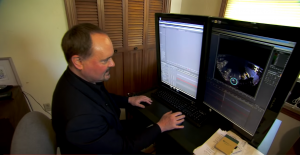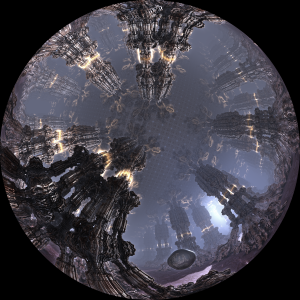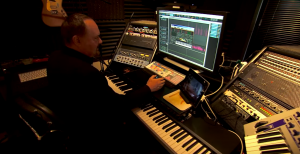 I love it when something comes across my desk that MAKES me want to dig deeper—find out more. Recently I have been spending more time reading our Cakewalk forum and I am amazed at how passionate and talented our user base is. I find myself going through posts, clicking links, poking around and being genuinely entertained and inspired. One recent post really got my attention and after inquiring directly to the user, I found myself turning into a CSI investigator (Cakewalk-SONAR Investigator) looking for clues to make some sense out of what I had just stumbled upon…
I love it when something comes across my desk that MAKES me want to dig deeper—find out more. Recently I have been spending more time reading our Cakewalk forum and I am amazed at how passionate and talented our user base is. I find myself going through posts, clicking links, poking around and being genuinely entertained and inspired. One recent post really got my attention and after inquiring directly to the user, I found myself turning into a CSI investigator (Cakewalk-SONAR Investigator) looking for clues to make some sense out of what I had just stumbled upon…
Opening the case:
Cakewalk User: bentleyousley – [My Inside Voice]: “…sounds a little suspicious to me—sounds like a Rock Star I should know.”
Case: Once and Future Cities: A Fractal Journey – [My Inside Voice]: “…I think I remember the word ‘fractal’ from some distant math class or something.”
Location: Kansas City – [My Inside Voice]: “best BBQ I’ve ever had in that city, but a SONAR user in Kansas City with a studio that looks like a rocket fuselage? Okaaaayyy???…”
Evidence: PBS, Kansas City Star, Kansas City Planetarium – [My Inside Voice]: “…PBS? A Planetarium? A home-brew large format projector and software? Fractal equations translated into visuals? A brilliant film all edited and scored meticulously in SONAR Platinum by one person made for planetariums? I’m IN…”
 My next plan of action in curing my curiosity was to try to contact this mysterious “bentleyousley” user through the Cakewalk forum IM feature. After a few days with no response, I was still on a mission to find out more, so I did something crazy; I Googled “Bentley Ousley.” I found more evidence of a real human along with fractal information, but nothing concrete. Then, I did the unthinkable; I typed in www.bentleyousley.com and boom—there it was: “Welcome to the website of award-winning Film and Media composer Bentley Ousley,” along with an actual email address. Case closed? No way.
My next plan of action in curing my curiosity was to try to contact this mysterious “bentleyousley” user through the Cakewalk forum IM feature. After a few days with no response, I was still on a mission to find out more, so I did something crazy; I Googled “Bentley Ousley.” I found more evidence of a real human along with fractal information, but nothing concrete. Then, I did the unthinkable; I typed in www.bentleyousley.com and boom—there it was: “Welcome to the website of award-winning Film and Media composer Bentley Ousley,” along with an actual email address. Case closed? No way.
About an hour later I was thankfully on the phone with Mr. Ousley trying to get my head around what I was hearing—and I mean this in a good and respectful way. The conversation was inspiring to me. You see after listening to all these politicians cackling at each other these days, and after hearing all the headline news in the background here in NYC, I needed to hear this great story of sheer authenticity, community, and talent.
Case Solved:
 Bentley Ousley is a ridiculously talented individual on many levels. Besides his talent of music composition and film creation, he also writes code and understands complex equations of which I cannot comprehend or explain for that matter. A while back, as a member of the Kansas Astronomical Society, Ousley started becoming more and more involved donating his much needed time and knowledge to the Gottlieb Planetarium in Kansas City.
Bentley Ousley is a ridiculously talented individual on many levels. Besides his talent of music composition and film creation, he also writes code and understands complex equations of which I cannot comprehend or explain for that matter. A while back, as a member of the Kansas Astronomical Society, Ousley started becoming more and more involved donating his much needed time and knowledge to the Gottlieb Planetarium in Kansas City.
Being a fan of “crazy ideas” he had a notion to combine his interest of Fractal Imagery with his passion of music and film creation, and bring this all together under the roof of the planetarium. But first there was a small problem; the planetarium needed a whole new projection system, and in today’s world these modern systems are not cheap. In fact a modern projection systems and accessories for a planetarium can run up to a cool $-mil with ease. Knowing that the dated and cash strapped planetarium was in desperate need of a makeover, Bentley decided to go one step further and focus his efforts on building what he describes as a “home-brew” planetarium projection system. [INSIDE VOICE]: (…who does that? 😉
 After researching many different avenues, Bentley and his newly assembled and dedicated team of local professionals ended up buying, on their own, an extremely bright projector and a delicately polished curved mirror that was custom-made in Australia. They coupled them with a Mac Pro computer and some special-sauce software to create a system that they say, is every bit as capable as the more expensive ones. The price: about $27,000 opposed to the anticipated 800k hiring out.
After researching many different avenues, Bentley and his newly assembled and dedicated team of local professionals ended up buying, on their own, an extremely bright projector and a delicately polished curved mirror that was custom-made in Australia. They coupled them with a Mac Pro computer and some special-sauce software to create a system that they say, is every bit as capable as the more expensive ones. The price: about $27,000 opposed to the anticipated 800k hiring out.
[Another odd fun-fact: If you’re ever designing and building a new “home-brew” planetarium projector system and software from scratch and become bored, enter into–and win a Warner Bros composer competition. During 2013 in the midst of creating his film, Bentley decided to enter into a Warner Bros Pictures fan-based composer competition called “Inspiring the Future” which he subsequently won.]
 With obstacle number one being solved, Bentley was now ready to move on to his next mission of researching fractal imagery, reaching out to fractal artists, and creating a masterpiece that could be displayed on the new system for others to enjoy. That is in fact what he did–which is now a 45-minute immersive sound and visual experience based on expressing mathematical formulas through computer code resulting in beautiful imagery. Bentley told AfterTheHarvestKC.org, “These fractal designers manage to distill the essence of both natural and man-made processes and landscapes into concise mathematical formulas and express them through the creation of amazingly engaging and believable miniature universes.”
With obstacle number one being solved, Bentley was now ready to move on to his next mission of researching fractal imagery, reaching out to fractal artists, and creating a masterpiece that could be displayed on the new system for others to enjoy. That is in fact what he did–which is now a 45-minute immersive sound and visual experience based on expressing mathematical formulas through computer code resulting in beautiful imagery. Bentley told AfterTheHarvestKC.org, “These fractal designers manage to distill the essence of both natural and man-made processes and landscapes into concise mathematical formulas and express them through the creation of amazingly engaging and believable miniature universes.”
“Once and Future Cities” is the sole creation of Bentley Ousley, computer programmer, composer, musician and SONAR user/Cakewalk Forum-browser who had a vision [crazy idea] to bring together an international team of “code” artists and fractal designers. And now thanks to his work in creating the projector and software for the planetarium, others get to enjoy his creative talents of film making and music composition in an immersive 60-foot 320×180 experience. Luckily for others outside of KC, his efforts are starting to spread to other communities where even most recently the PBS syndicated show SciTech Now exhibited his work in a great light in episode 215.
Closing the case:
So let’s recap: It’s pretty simple; computer programmer, composer, musician and SONAR user Bentley Ousley from Kansas City in his spare time decided to build a home-brewed planetarium projector system and software normally costing $800k for under $30K–where he then single-handedly created from scratch an incredible 45-minute immersive film (including the music score) bringing together the best fractal artists in the world and exemplifying their math-art onto the said 320×180 planetarium platform—where now PBS and other large companies such as distributor, Immersive Theaters, in the U.K. are starting to get involved on a bigger scale because they found out what I have found out in the last 48 hours.
The facts of my investigative mission are also explained very well here in a local KC news story:
[Bentley was kind enough to answer some of my CSI (Cakewalk SONAR Investigative) questions:]
[Cakewalk]: What is your background in music composition?
[Bentley Ousley]: I started composing music for television commercials, and that led to soundtracks for industrial films. About 12 years ago I found myself scoring specialty science films and becoming involved in planetarium immersive productions. That experience led me to producing and scoring “Once and Future Cities: A Fractal Journey”.
[Cakewalk]: What does a normal SONAR project look like when you produce a composition?
[Bentley Ousley]: It depends greatly on what the project needs. For “Once and Future Cities: A Fractal Journey”, the score was influenced heavily by  electronic/ambient-music. I started very simply (usually with a single synth sound that I found intriguing … For this project, Alchemy, Reaktor, (Arturia’s) CS80V and (Arturia’s) ARP2600 seemed to have been the inspirational starting points). I then built the idea based on where the composition and visuals seemed to take me. Most of the synth-based stuff is done within SONAR on a single PC. For orchestral scoring, I have a multi-machine setup using Vienna Ensemble Pro that drives several different orchestral libraries. The template is divided by the various sections of the orchestra and my “go-to” articulations and multis. I ‘live’ in track view. Even though I learned recording on traditional consoles, I don’t find clinging to that paradigm very useful for me.
electronic/ambient-music. I started very simply (usually with a single synth sound that I found intriguing … For this project, Alchemy, Reaktor, (Arturia’s) CS80V and (Arturia’s) ARP2600 seemed to have been the inspirational starting points). I then built the idea based on where the composition and visuals seemed to take me. Most of the synth-based stuff is done within SONAR on a single PC. For orchestral scoring, I have a multi-machine setup using Vienna Ensemble Pro that drives several different orchestral libraries. The template is divided by the various sections of the orchestra and my “go-to” articulations and multis. I ‘live’ in track view. Even though I learned recording on traditional consoles, I don’t find clinging to that paradigm very useful for me.
There are several third-party VSTs I find myself using for just about every project: Waves L3 (they make some damn fine compressors and limiters even considering to some their perceived corporate reputation), Kush Clariphonic and Kush UBK-1. I own all the Kush VSTs. They are so rooted in musicality, you have to be trying really hard to make them sound bad. For “Once and Future Cities: A Fractal Journey”, I wanted a very specific texture of reverb for the ambient sounds to ‘live’ in. I thought I wanted something that had the same ‘vibe’ as the Lexicon 480L. I wound up choosing the Valhalla verb and though it doesn’t produce verbs that are an exact clone of the 480L, I found it lent it’s own unique character to the project and I’ve been very happy with the results.
Here is an image of my starting VEP template for Sonar.
This seems to strike a good balance between performance and efficiency for me. I could make it more specific, but then I end up with a bunch of instruments I hardly ever use. I could make it more general, but then I spend a great deal of time mapping new instruments. This maps to my “go-to” instruments and multis across several orchestral and other libraries from EastWest, Project Sam, Kirk Hunter, Vienna, Cinesamples, Complete Classical Collection.
 Expanding each of the folders in track view, you find the individual midi channels assigned to individual instruments within that particular VEP Server instance. Each folder starts with one stereo output from each VEP instance, but this can easily be expanded if needed.
Expanding each of the folders in track view, you find the individual midi channels assigned to individual instruments within that particular VEP Server instance. Each folder starts with one stereo output from each VEP instance, but this can easily be expanded if needed.
I connect to seven instances of VEP on another PC acting as the VEP Server. The connection is made in Sonar with the VEP host VSTs. This VST communicates with the VEP Server over the network, transmitting and receiving both midi and audio. The other two instances are Event Input VSTs that expand the number of midi channels that are available for a given instance of VEP.
Here is a screen capture of the Server desktop:
I used to regularly use three server PCs plus a DAW PC for orchestral scoring, but as the machines get more powerful and SONAR continues to become more efficient, I find I hardly ever need more than one server and one host.
[Cakewalk]: What do you like about SONAR Platinum opposed to older versions of SONAR?
[Bentley Ousley]: I started with Sonar 4 twelve years ago, so I’ve seen a lot of changes. I use the console emulation on everything (A-type is my favorite). I use the PC EQ without hesitation and really like the built-in frequency analyzer. I like the way the workflow seems to get smoother and I’m looking forward to seeing what is coming down the pike.
[Cakewalk]: What is your workflow for writing, composing, and producing, and then how does it come together generally as a full master?
[Bentley Ousley]: Depends on the project again. For TV commercials, I tend to have the whole idea in my head before I start. For longer pieces, I may have a mental map for the musical structure, but find that letting some ‘happy accidents’ happen usually elevates the piece.
 I tend to mix as I go. It helps me understand where I’m going and recognize when I get there. I’m very familiar with my monitors, but always check the mix on other sources. I mix in a small room and it is very easy to misjudge the low-end. I find headphones with a slight low-end bump can help me discern problems in the bass part of the mix (independent of the room.) I have a set of Koss Porta-Pros I use for this. If the low-end is tight on my monitors _and_ the low-end is tight on my Porta Pros then I’m usually good to go.
I tend to mix as I go. It helps me understand where I’m going and recognize when I get there. I’m very familiar with my monitors, but always check the mix on other sources. I mix in a small room and it is very easy to misjudge the low-end. I find headphones with a slight low-end bump can help me discern problems in the bass part of the mix (independent of the room.) I have a set of Koss Porta-Pros I use for this. If the low-end is tight on my monitors _and_ the low-end is tight on my Porta Pros then I’m usually good to go.
For TV commercials an air-able master is expected (and quickly!). I find a touch of L3 in multiband mode and a smidgen of Clariphonic on the master bus usually puts me right where I need to be. If I seem to need more than that, it usually indicates a problem that can be corrected in the mix.
[Cakewalk]: What were some of the features or items in general that made you switch from Pro Tools to SONAR.
[Bentley Ousley]: In 2004, I found myself needing a DAW with a more complete MIDI implementation than Pro Tools was offering at that time. I looked at the usual suspects (Cubase, Logic, Etc…) and liked the direction that Sonar seemed to be heading. What really clinched my decision was how much less toxic the SONAR forum seemed compared to the other DAWs. Developers answering questions? Blatant unrestrained civility? Sign me up!
For more information:
SONAR Platinum
Bentley Ousley
KC Planetarium
Once and Future Cities



